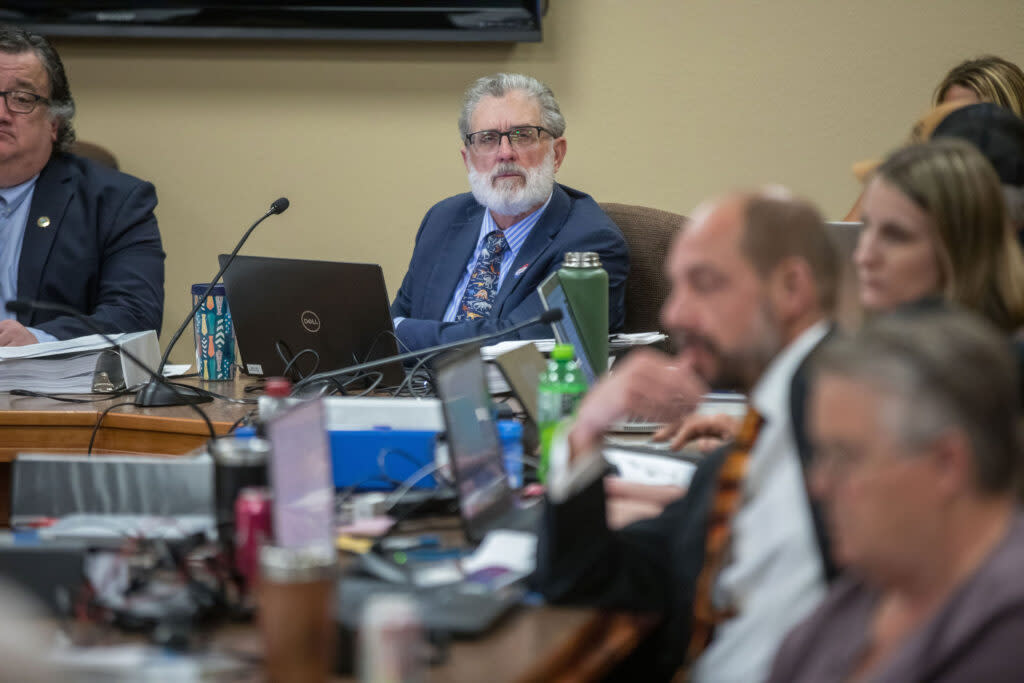Summit’s carbon storage plans face strong objections at ND permit hearing

Lynn Helms, center, director of the Department of Mineral Resources, listens Tuesday, June 11, 2024, during a public hearing in Bismarck on proposed carbon dioxide storage that would be connected to the Summit Carbon Solutions pipeline. (Kyle Martin/North Dakota Monitor)
The underground carbon dioxide storage plan that is key to the Summit Carbon Solutions pipeline project faced significant scrutiny during a three-day hearing last week in North Dakota.
Summit proposes to transport CO2 emissions captured from ethanol plants in five states for permanent storage in an underground rock formation in North Dakota. In addition to needing approval for the pipeline, the company needs permits from the North Dakota Industrial Commission for three underground storage facilities in Oliver and Mercer Counties.
At least 90% of property owners within each storage area have voluntarily signed leases with Summit for use of their pore space, or underground cavities or voids in the rock formation, the company told regulators with the Department of Mineral Resources.
Property owner Kurt Swenson strongly objected to Summit’s request to regulators to force him and other nonconsenting landowners to participate in the project.
“The state can try and take it. You’re going to end up taking it from my cold, dead hands,” said Swenson, who owns 1,400 acres in or near the proposed storage areas.
Swenson and Derrick Braaten, an attorney representing Swenson and nearly a dozen other landowners, raised concerns about potential health hazards, lack of economic benefit, unfair treatment of landowners and Summit’s refusal to share crucial modeling data.
“I think they should be denied,” said Swenson, adding the state will likely be forced to spend taxpayer funds to defend itself against lawsuits if the North Dakota Industrial Commission approves the permits.
Director of Mineral Resources Lynn Helms called the hearing “one of the most contentious” he’s ever endured.
Summit is requesting to force nonconsenting property owners to lease their pore space through a legal process called amalgamation. The process – similar to eminent domain used for pipeline rights-of-way – is the subject of an ongoing lawsuit against the state. Unlike eminent domain, however, amalgamation does not involve a jury weighing in on landowner compensation, which the landowner plaintiffs argue is unconstitutional.
Helms said Friday during a monthly press briefing that the process is different for pore space because the decisions involve studying geology, underground pressures and other technical considerations.
Kenneth Hintz, the only other property owner to testify at the hearing, supports Summit’s project. Hintz, who has worked with Summit on the project since 2021, has no complaints with how the company has communicated with landowners and believes the project will have a positive impact on the area.
“The project will provide new industry for North Dakota, supplemental income for farmers and ranchers, and new tax dollars for the county,” Hintz said.
Summit executives and experts contracted with the company testified the proposed project meets the legal requirements for a permit listed in state law.
Summit’s Midwest Carbon Express pipeline, if completed, will have the capacity to transport 18.5 million metric tons of CO2 annually to the three storage facilities in Oliver and Mercer Counties.
The three storage facilities Summit is applying for will serve as the end point for the company’s Midwest Carbon Express project, a 2,000-mile pipeline expected to collect carbon dioxide from 57 ethanol plants and one sustainable aviation fuel facility across five states, including Nebraska, and transport the CO2 to North Dakota for permanent storage underground.
“This is three enormous storage facilities, which will really change the nature of carbon emissions in the Midwest,” Helms said.
The CO2 will be pumped into the Broom Creek Formation, a layer of sandstone reservoir and saline aquifer between 5,587 feet and 6,421 feet below the surface. “Confining layers” of rock formations will prevent the CO2 from moving vertically and contaminating sources of drinking water, according to modeling performed by the Energy and Environmental Research Center at the University of North Dakota. The CO2 will instead expand horizontally across the storage facility area over time.
Braaten disputes the accuracy of the EERC’s modeling.
Summit estimates the three storage facilities will have a combined capacity for 352 million metric tons of carbon dioxide. The company plans to fill the storage area over the course of 20 years, injecting an average of 17.6 million metric tons of CO2 annually. Leases signed with landowners include provisions allowing Summit to extend the life of the storage facility for an additional 20 years in exchange for a lump sum payment.
The storage facility’s capacity is a fraction of North Dakota’s pore space, estimated to have the potential to store 250 billion metric tons of CO2 according to the Department of Energy.
“It’s a very prolific storage resource,” said Wade Boeshans, Summit’s executive vice president.
Helms, who is retiring this month, said technical staff with the Department of Mineral Resources will review the information and likely make a recommendation to the full North Dakota Industrial Commission by September or October. The commission, which makes the final decision, is comprised of Gov. Doug Burgum, Attorney General Drew Wrigley and Agriculture Commissioner Doug Goehring.
This article first appeared in the North Dakota Monitor, a sister site of the Nebraska Examiner in the States Newsroom network.
The post Summit’s carbon storage plans face strong objections at ND permit hearing appeared first on Nebraska Examiner.

